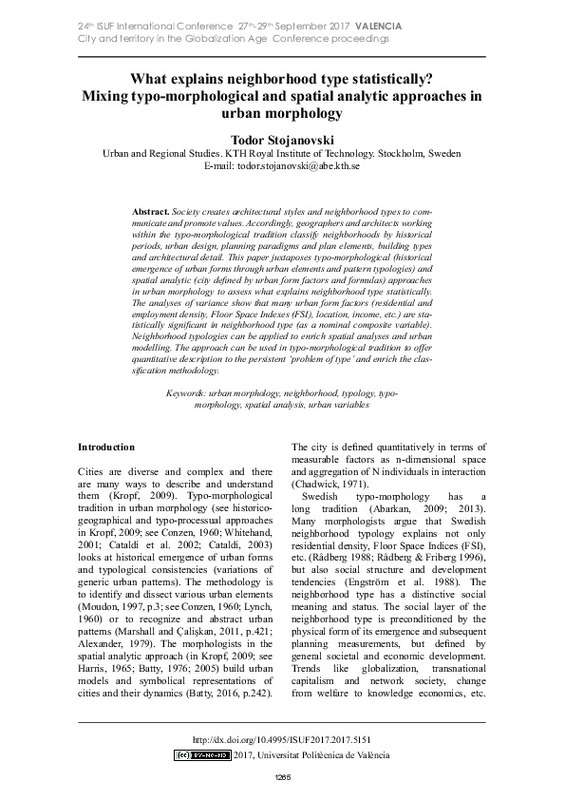JavaScript is disabled for your browser. Some features of this site may not work without it.
Buscar en RiuNet
Listar
Mi cuenta
Estadísticas
Ayuda RiuNet
Admin. UPV
What explains neighborhood type statistically? – Mixing typo-morphological and spatial analytic approaches in urban morphology
Mostrar el registro sencillo del ítem
Ficheros en el ítem
| dc.contributor.author | Stojanovski, Todor
|
es_ES |
| dc.date.accessioned | 2018-12-05T08:40:48Z | |
| dc.date.available | 2018-12-05T08:40:48Z | |
| dc.date.issued | 2018-04-20 | |
| dc.identifier.isbn | 9788490485743 | |
| dc.identifier.uri | http://hdl.handle.net/10251/113476 | |
| dc.description.abstract | [EN] Society creates architectural styles and neighborhood types to communicate and promote values. Geographers and architects accordingly classify neighborhoods by historical periods, urban design, planning paradigms and plan elements, density, building types and architectural detail. This paper juxtaposes typo-morphological (historical emergence of urban forms through urban elements and pattern typologies) and spatial analytic (city defined by urban form factors and formulas) approaches in urban morphology to assess what explains neighborhood type statistically. The analyses of variance show that many urban form factors (residential and employment density, mix of residences and jobs, Floor Space Indexes (FSI), location, income, etc.) are statistically significant in neighborhood type (as a nominal composite variable). This means that neighborhood typologies be applied in spatial analyses and urban modelling as classes (context variables). The approach can be used in typo-morphological tradition to offer quantitative description to the persistent ‘problem of type’ and enrich the classification methodology. | es_ES |
| dc.format.extent | 18 | es_ES |
| dc.language | Inglés | es_ES |
| dc.publisher | Editorial Universitat Politècnica de València | es_ES |
| dc.relation.ispartof | 24th ISUF International Conference. Book of Papers | es_ES |
| dc.rights | Reconocimiento - No comercial - Sin obra derivada (by-nc-nd) | es_ES |
| dc.subject | Urban morphology | es_ES |
| dc.subject | Neighborhood | es_ES |
| dc.subject | Typology | es_ES |
| dc.subject | typomorphology | es_ES |
| dc.subject | Spatial analysis | es_ES |
| dc.subject | Urban variables | es_ES |
| dc.title | What explains neighborhood type statistically? – Mixing typo-morphological and spatial analytic approaches in urban morphology | es_ES |
| dc.type | Capítulo de libro | es_ES |
| dc.type | Comunicación en congreso | es_ES |
| dc.identifier.doi | 10.4995/ISUF2017.2017.5151 | |
| dc.rights.accessRights | Abierto | es_ES |
| dc.description.bibliographicCitation | Stojanovski, T. (2018). What explains neighborhood type statistically? – Mixing typo-morphological and spatial analytic approaches in urban morphology. En 24th ISUF International Conference. Book of Papers. Editorial Universitat Politècnica de València. 1265-1272. https://doi.org/10.4995/ISUF2017.2017.5151 | es_ES |
| dc.description.accrualMethod | OCS | es_ES |
| dc.relation.conferencename | 24th ISUF 2017 - City and Territory in the Globalization Age | es_ES |
| dc.relation.conferencedate | Septiembre 27-29,2017 | es_ES |
| dc.relation.conferenceplace | Valencia, Spain | es_ES |
| dc.relation.publisherversion | http://ocs.editorial.upv.es/index.php/ISUF/ISUF2017/paper/view/5151 | es_ES |
| dc.description.upvformatpinicio | 1265 | es_ES |
| dc.description.upvformatpfin | 1272 | es_ES |
| dc.type.version | info:eu-repo/semantics/publishedVersion | es_ES |
| dc.relation.pasarela | OCS\5151 | es_ES |








